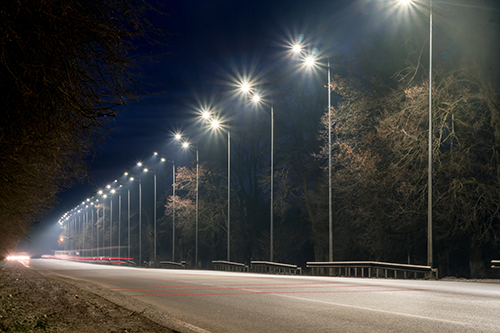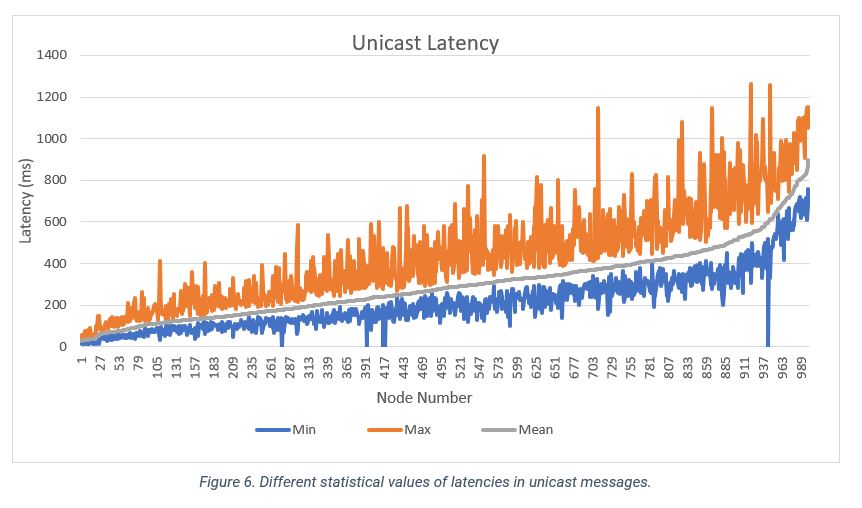Schedule a Teams Meeting with Radiocrafts or leave a message on our contact form to learn more about our Sub-GHz mesh networking solution, RIIM, optimized for efficient Smart Street Lighting Networks!

Want to control your entire city’s streetlights via a complete sub-GHz wireless communication network entirely embedded in an RF module? Then Radiocrafts’ Industrial IP Mesh (RIIM) Network is the solution for you!

Large network - Up to 1000 nodes on a single gateway

Large Coverage - 40x40 km, 700 meters between each node

High-Throughput Networking for vast amounts of communication data

No license or subscription fees

2-way symmetrical communication

Multicast - Create dynamic groups of street lights
Explore the results of our large 1000-node network street lighting simulation below.
Radiocrafts’ Solution for Smart Street Lighting – RIIM

RIIM by Radiocrafts is an easy-to-use, Sub-GHz, wireless communication network completely embedded in an RF module. It includes all the critical components for a complete wireless communication mesh and has no license fee or subscription costs. It is ready to go when you buy the module. Additionally, since RIIM is a mesh network, it is self-forming, self-healing, and self-optimizing. This is simplifies the deployment of your street lighting network greatly.
RIIM provides your Smart Street Lighting network with:
Unmatched Robustness and Reliability
RIIM provides unmatched reliability in data transmission success rates for Smart Street Lighting networks thanks to the supported Time-Synchronized Channel Hopping and Adaptive Frequency Agility features.
Time Synchronized Channel Hopping (TSCH) works by re-sending a data packet that was lost between two devices on a different channel in the next available time slot. It is a channel hopping mode designed to make a mesh with minimal packet collisions and higher reliability. A TSCH network has a proven reliability rate of 99.99% successful data packets.
RIIM also supports the Adaptive Frequency Agility which allows for high-throughput networking with minimal packet loss by taking the allowed duty cycle in Europe from 1% to around 40%! AFA works by scanning all radio channels and marking the ones which are often found to be noisy. Those channels are then dropped from the channel hopping list ensuring that the radio only uses the best channels with the least noise.
In the US high-throughput networking is not a big issue but you can still take advantage of the robustness. Using an example, this means that you can now go from 1 packet reaching the Border Router every 4 seconds to 40 packets reaching the Border Router every 4 seconds! This feature is essential to keep up with the vast amounts of data communication required from smart street lighting deployments. For even more data throughput, RIIM supports a 150 kbps mode as well.
RIIM also supports faulty node detection where the Border Router sends a message to every node asking if they are still connected to the network. If the Border Router does not receive a reply from one of the nodes, this means that this node is lost.
Learn more about TSCH and Adaptive Frequency Agility in the application notes and demos below.
Efficient Local and Network Wide Control of Devices For Remote Configuration Management
RIIM includes the ICI framework. An ICI application is always running on the module to tailor the modules behavior to the customers unique requirements. The ICI application configures the radio network, the modules hardware interfaces, and defines when to read/write to those interfaces. ICI makes it possible for the user to directly interface to virtually any sensor and/or actuator, such as a motion sensors, GPS, dim control sensors and more, removing the need for external circuitry. It supports mist computing to reduce bandwidth requirements and for fast responses to local events. Examples include updating the brightness of light bulbs in a specific area of the city and more.

Time-Synchronization is an essential feature in RIIM for smart street lighting as well. It supports the management of exact start and stop times for certain events. The operator can automatically turn all streetlights on at 17:00 at the exact same time, then off again at 07:00. Similarly, the user can turn on a certain group of light bulbs as soon as another group is dimmed. Additionally, a certain sensor reading can be time stamped by adding the real time information into the sensor reading packet. This way, important events can be tied to certain times, to allow for better data analytics.
RIIM also supports multicast which allows for remote configuration management. In a smart street lighting application, remote configuration management is essential because it enables software upgrades over the air or other mass distribution messages to reduce the on-air communication time. Additionally, in massive networks, multicast enables you to create dynamic groups of streetlights. This allows you to update a certain parameter for those specific node groups all at the same time. Examples include, turning on/off lights in a specific area of the city, adjusting the colour of the lights, adjusting the dimness, broadcast message of new schedules, and more. This makes maintenance and management of the network much simpler.
Local multicast is similar to normal multicast as described above, except it only reaches nodes registered as the first neighbor. This allows for less network traffic, less latency, and less network flooding. For example, let’s say you have configured the streetlights to always be off and only turn on when a car drives by then they turn off again. You don’t need to turn on the lights for the entire network when a single car is driving by. This is when local multicasting comes in. The first light pole detects that the car is coming so it sends a local multicast message to its immediate neighbors to turn on the lights too, then they turn off once the car has driven by.
Learn more about Time-Synchronization and an example code in ICI in the application notes and demo videos below.

RIIM vs Zigbee vs LoRa
The competitive advantage of RIIM versus Zigbee in smart street lighting is that RIIM can support longer range (700 meters between each node in urban environments) with each mesh hop (28 mesh hops), and up to 1000 nodes for a single border router, reducing the cost of the installation as less gateways are needed to support a large scale deployment.
The competitive advantage of RIIM over LoRa in smart street lighting is that a RIIM network supports 2-way symmetrical communication which essential for Over-The-Air Updates. This means that the user can update the user defined ICI firmware when the network is deployed/in full operation. New sensors/controllers can be added when the need arises and the user can broadcast messages of new schedules efficiently. One major advantage is that RIIM is significantly more reliable than LoRa. RIIM supports Time Synchronized Channel Hopping (TSCH) TSCH works by re-sending a data packet that was lost between two devices on a different channel in the next available time slot. It was designed to make a mesh with less packet collision and higher reliability. A TSCH network has proven to have a reliability of up to 99.99%. RIIM is also protected by encryption using a pre-shared key and supports DTLS end to end security.

Large Network Smart Street Lighting Simulations Using RIIM
Our large network street lighting simulations are simulations that fulfill various smart street lighting scenarios requested by Radiocrafts customers.
One simulation entailed:
- 1000 nodes (1 Border Router and 999 Mesh Routers)
- City-like layout
- 40m in average between each light pole
- Broadcast messages every 4 hours
- Assumed maximum range between a node can communicate at is 210 m (With a good antenna design and LoS between light poles this is expected to be longer than this)
- Sensor reading from each light pole every 2 hours
- Run over a 24-hour period.
One major issue with large networks is how to prevent packet collisions. RIIM has various features which allow it to form large 1000-node networks quickly and reliably.
The best way to go about forming a large network using RIIM is “Synchronized Joining”, which is a measure by which the joining process is altered to allow enough time for nodes to join the network and avoid creating a bottleneck effect at the Border Router. This is done by using the “Random Function” feature which is already available in the RIIM API. This function can be used to set a random offset in the joining command for the nodes. This one-shot timer will create a random delay in each of the nodes’ joining procedure, limiting the number of nodes communicating with the Border Router at any instant.
Another feature in RIIM which can be used to avoid common problems seen in large networks is setting the “Network Type” to “Large Network” through RIIM’s APIs. Radiocrafts has created a set of parameters custom-made for large networks, which can be activated through ICI just by setting the network type to “Large Network”.
Simulation Results
Network Formation
The network was allowed to form with a joining delay offset of 10 minutes. This means the 999 mesh router nodes started communicating with the Border Router at random times in a 10-minute window. The 1000 nodes took 9 minutes to form after the last node joined the network.
Multicast Latency
Multicast is a feature in RIIM which allows the Border Router to broadcast messages. The child nodes repeat this message to ensure that even the most remote node still gets it.
Multicast messages are of utmost importance in smart street lighting applications. They are the means by which the core management system will send “turn lights on/off messages”.
The average time observed for the 5 multicast messages was 27,899 seconds.

Unicast Latency
Unicast messaging refers to messages sent from a child node to the Border Router. Such messages can be very important as it might be a lamp trying to inform the core management system of a certain failure it has. Therefore, unicast latency is a crucial parameter to consider in street lighting networks.
Since the network has 1000 nodes, sending a unicast message every 4 hours, it can be concluded that a total of 6000 messages were sent. Out of these 6000 messages, only 3 messages were lost.
We also measured the time it took for unicast messages to be sent from each node and the highest average value was around 900ms. This means that in a network with 1000 nodes, the Border Router will receive messages from the furthest node with an average delay of just under one second.
You can read the application note we have written on the Simulation Results below!
Support Tools For RIIM
We recommend that you buy a RIIM Development Kit in your early stage product evaluation. The development kits are designed to be easy to use and to very quickly support a wireless link or network, where you can make a good analysis of the network performance.
RIIM is supported in most countries in the world. Explore the possibilities of using RIIM in your country in the application note below!
You can buy the RIIM Development kit from:
- Digi-Key
- Or from a distribution partner in your country.
Read more about the RIIM Network here.
Learn about the different RIIM Parts and Tools here.
Read our extensive documentation on RIIM, including datasheets, User Manuals, Development Kit documentation, Application Notes and more, here.
Download Software Tools for RIIM here.
Watch tutorial videos on how to use the RIIM Development Kit here.
Schedule a Teams Meeting with Radiocrafts or leave a message on our contact form to learn more about our Sub-GHz mesh networking solution, RIIM, optimized for efficient Smart Street Lighting Networks!
